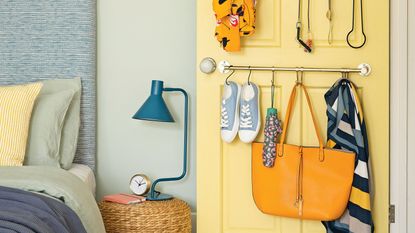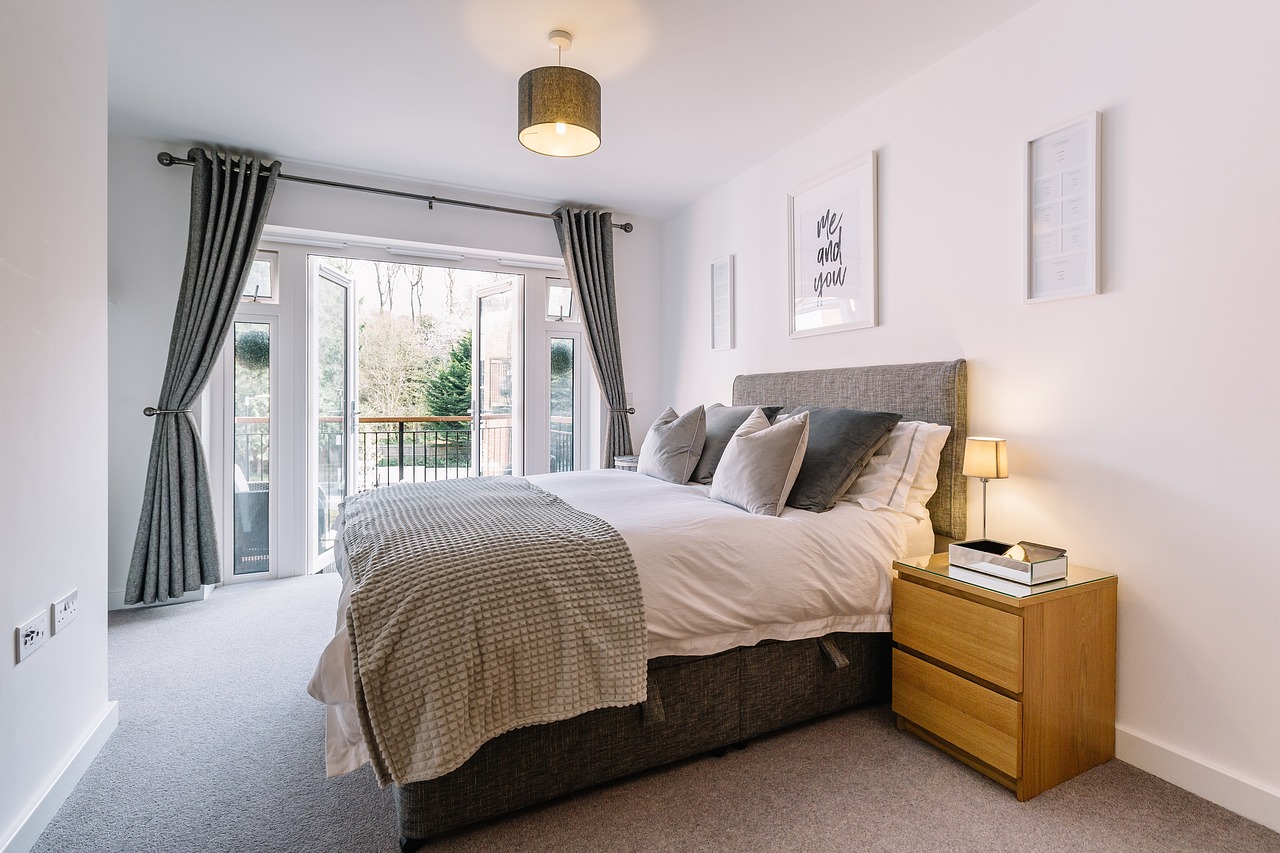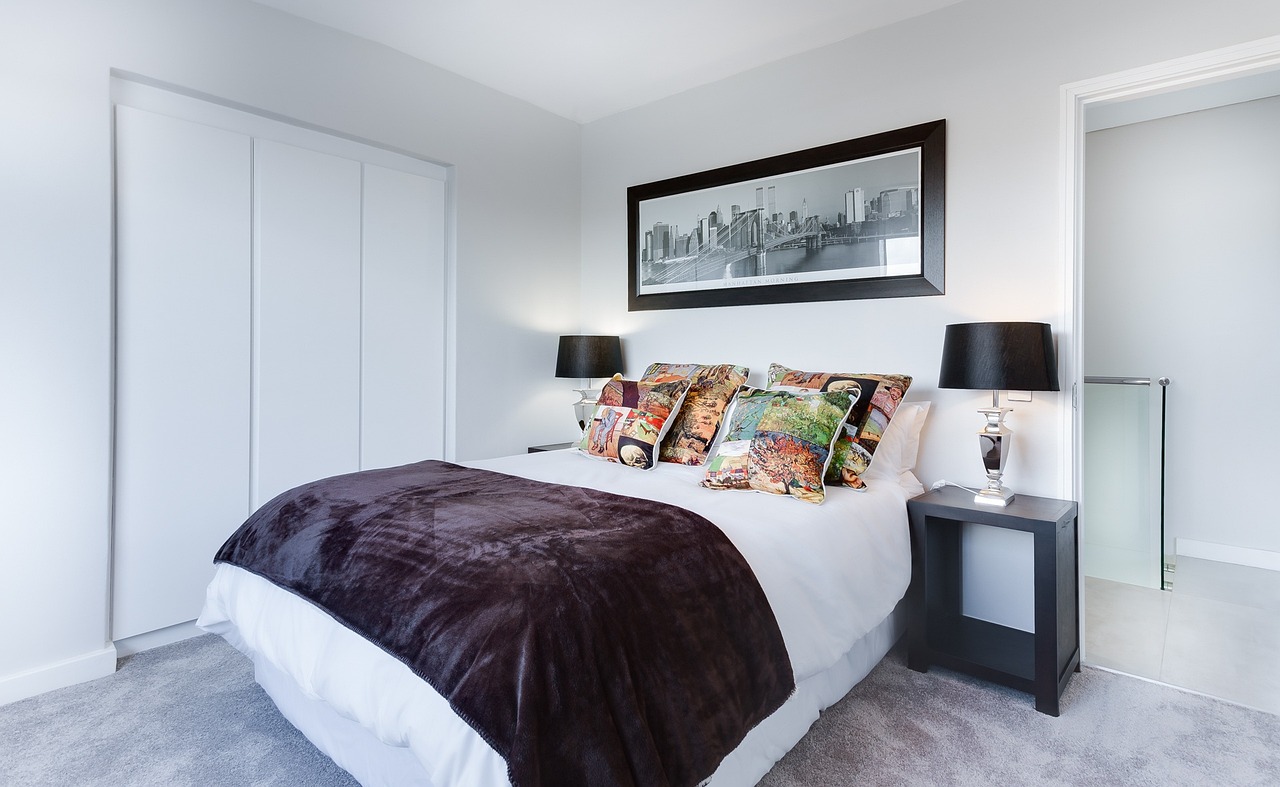Table of Contents
In our fast-paced and cluttered world, the concept of Zen and minimalism has gained significant attention for its ability to bring tranquility and harmony into our lives. When it comes to creating a peaceful retreat within your home, the bedroom is the perfect place to start. In this article, we will explore the art of achieving Zen through minimalist bedroom design, allowing you to create a serene and calming space that promotes a peaceful mind.
In our fast-paced and cluttered world, finding serenity and harmony is a pursuit worth embracing. The principles of Zen and minimalism offer a path toward achieving just that. Your bedroom, as the most intimate and personal space in your home, serves as the ideal canvas for practicing the art of minimalist design to cultivate tranquility. Here’s how you can embark on this journey to create a peaceful sanctuary within your bedroom:
1. Declutter and Simplify: Begin by decluttering your bedroom. Remove items that are not essential to the room’s function or do not contribute to a sense of calm. Keep only what brings you joy and serves a purpose. Minimalism is about quality, not quantity.
2. Mindful Furniture Selection: Choose furniture with clean lines and a simple, unobtrusive design. Opt for pieces that have multiple functions to maximize space efficiency. A platform bed with storage drawers, for example, can eliminate the need for additional dressers or under-bed storage.
3. Neutral Color Palette: Embrace a neutral color palette that includes soft whites, calming grays and muted earth tones. These colors promote a sense of serenity and provide a blank canvas for incorporating natural textures and materials.
4. Quality Over Quantity: Invest in high-quality bedding, linens and furniture that will stand the test of time. Minimalist design emphasizes the longevity and craftsmanship of each piece, reducing the need for frequent replacements.
5. Functional Storage: Incorporate concealed storage solutions to keep your bedroom free of visual clutter. Wall-mounted shelves, built-in closets and hidden storage under the bed or behind mirrored panels can help maintain a tidy appearance.
6. Thoughtful Decor: Select decor items mindfully. A few carefully chosen pieces, such as a piece of wall art or a vase of fresh flowers, can add personality and warmth to your bedroom without overwhelming the space.
7. Zen-inspired Elements: Integrate elements inspired by Zen philosophy, such as a small indoor Zen garden, a Japanese-style shoji screen or a meditation cushion. These additions can enhance the calming ambiance of your bedroom.
8. Soft Lighting: Create a soothing atmosphere with soft, diffused lighting. Use warm-toned bulbs and consider adding dimmer switches to control the intensity of light. Incorporating natural light through strategically placed windows or sheer curtains also contributes to a peaceful aura.
9. Mindful Arrangement: Carefully arrange your bedroom to maximize flow and functionality. Ensure that the layout promotes relaxation and doesn’t hinder movement or create unnecessary obstacles.
10. Daily Rituals: Embrace mindful daily rituals in your minimalist bedroom, such as meditation or gentle stretching exercises. These practices can help you start and end each day with a calm and focused mind.
11. Personal Retreat: Finally, remember that your minimalist bedroom is your personal retreat. Customize it to align with your unique preferences and needs. Over time, you’ll find that the intentional design choices you’ve made contribute to a sense of tranquility and mindfulness that permeates your daily life.
By infusing the principles of Zen and minimalism into your bedroom design, you create a space that serves as a serene oasis amidst the chaos of the world. It’s a place where you can unwind, rejuvenate and find inner peace, ultimately enhancing the quality of your life in a profound way.
Explore this link for a more extensive examination of the topic: 7 Zen Room Ideas for Every Personality Type | Pacaso
Clear the Clutter
The foundation of minimalist bedroom design is decluttering. Begin by evaluating your possessions and keeping only the items that serve a practical purpose or hold deep sentimental value. Clear out excess furniture, unnecessary decor and items that do not contribute to a peaceful atmosphere. By simplifying your surroundings, you pave the way for a clearer, more tranquil mindset.
Certainly, here’s an extended idea:
“At the heart of minimalist bedroom design lies the transformative power of decluttering. It’s a practice that goes beyond tidying up; it’s about curating your living space intentionally, creating an environment that promotes tranquility and enhances your overall well-being. To embark on the minimalist journey in your bedroom, start with a meticulous decluttering process that will not only simplify your surroundings but also cultivate a serene and focused mindset.
The first step in this decluttering journey is a thorough evaluation of your possessions. Take the time to assess each item in your bedroom, from furniture to decor to personal belongings. Ask yourself whether each item serves a practical purpose or holds a deep sentimental value. If an item doesn’t meet one of these criteria, consider whether it truly belongs in your serene sanctuary.
Letting go of excess is a liberating experience. It involves parting with items that are no longer necessary or meaningful to you. This could be clothing you no longer wear, gadgets that have become obsolete or decor that no longer resonates with your aesthetic. By eliminating the superfluous, you create space for what truly matters and reduces visual noise, fostering a sense of clarity and calm.
Examine your furniture choices as well. In minimalist bedroom design, every piece should have a clear function and contribute to the room’s peaceful atmosphere. If you have furniture items that are redundant or bulky, consider whether they can be repurposed or replaced with more streamlined alternatives. The goal is to create an open and uncluttered space that invites relaxation.
Unnecessary decor can also hinder the minimalist ambiance. Take a critical look at the decorations in your bedroom and choose those that align with your vision of tranquility. Often, a few carefully selected decor pieces that hold personal significance can have a more profound impact than an array of trinkets that clutter your space.
As you declutter, you’re not just simplifying your physical surroundings; you’re also cultivating a clearer, more tranquil mindset. The process of letting go can be emotionally cleansing, allowing you to release attachments to material possessions and embrace the freedom of simplicity. This mental clarity extends beyond your bedroom and can positively affect other aspects of your life, fostering a sense of focus and intentionality.
In conclusion, minimalist bedroom design begins with decluttering—a deliberate and transformative process that simplifies your surroundings and cultivates a serene mindset. By evaluating your possessions, eliminating excess and curating your space intentionally, you create a tranquil sanctuary that extends the benefits of minimalism to your daily life. Your minimalist bedroom becomes a reflection of your priorities, a place of refuge and a source of clarity and peace.”
Should you desire more in-depth information, it’s available for your perusal on this page: Zen Bedroom Ideas: 10 Blissful Schemes For Rest | Storables

Choose Calming Colors
Color plays a crucial role in setting the tone for your minimalist bedroom. Opt for a neutral color palette dominated by soft whites, muted grays and calming earth tones. These hues create a soothing backdrop that promotes relaxation and serenity. Incorporate color sparingly through accents like a single piece of artwork or a throw pillow to maintain the minimalist aesthetic.
Color choice in a minimalist bedroom is like painting the canvas of tranquility. It’s the key to achieving that perfect balance between simplicity and warmth. Let’s dive deeper into the world of minimalist bedroom colors and explore how they can transform your space:
1. The Power of Neutrals: Neutrals are the foundation of minimalist design. Soft whites, muted grays and calming earth tones provide a clean and uncluttered canvas for your bedroom. These colors not only create a sense of spaciousness but also allow your mind to relax. The neutrality of these hues promotes a feeling of serenity that’s perfect for unwinding after a long day.
2. Embrace Minimal Contrast: In a minimalist bedroom, it’s wise to avoid bold contrasts or overly vibrant colors. Instead, aim for a subtle and harmonious color palette. Think about using various shades of your chosen neutrals to add depth and interest without overwhelming the space.
3. Texture and Tactility: Since a minimalist room often lacks bold colors, texture takes on a more significant role. Consider incorporating different textures through textiles, such as a chunky knit throw, a silky smooth duvet cover or a plush area rug. These tactile elements not only add visual interest but also create a sense of coziness.
4. Accents as Art: Minimalist bedrooms are renowned for their simplicity, but that doesn’t mean you have to entirely eliminate color. Introduce color accents strategically. A single piece of artwork with a subtle pop of color or a well-chosen throw pillow can be a focal point in an otherwise neutral room. These accents draw the eye and create visual interest without disrupting the minimalist aesthetic.
5. Natural Elements: Incorporating natural elements like wooden furniture or greenery can introduce subtle color variations while maintaining the overall minimalist vibe. The warm, earthy tones of wood or the green of potted plants can breathe life into your bedroom without overwhelming it with color.
6. Play with Light: Lighting plays an essential role in color perception. Consider how natural light and artificial lighting sources interact with your chosen colors. Soft, diffused lighting can create subtle variations in the color palette throughout the day, adding depth and dimension to your minimalist space.
7. Mindful Color Psychology: While choosing colors, keep in mind the psychological impact they can have. Soft blues or greens can evoke a sense of calm, while warm earth tones can add a cozy and grounding feel. Reflect on the mood you want to create in your bedroom and select colors accordingly.
8. Maintain Simplicity: Above all, remember that the essence of minimalism lies in simplicity. Fewer colors often equate to a more tranquil and uncluttered atmosphere. Be selective in your color choices, ensuring that they align with your vision of a peaceful and minimalist bedroom.
In summary, the color palette you choose for your minimalist bedroom has the power to shape its atmosphere and influence your state of mind. Neutral tones provide a serene backdrop, while well-placed color accents add personality and depth. The key is to strike a delicate balance that fosters both relaxation and a minimalist aesthetic, creating a bedroom that’s not only visually pleasing but also a peaceful retreat from the world.
For additional details, consider exploring the related content available here 7 Zen Room Ideas for Every Personality Type | Pacaso

Embrace Functional Simplicity
Minimalist design prioritizes functionality over extravagance. Select essential furnishings that serve their purpose efficiently. A simple platform bed with clean lines and hidden storage, sleek nightstands and unadorned dressers are ideal choices. Each piece should have a purpose and contribute to the overall sense of tranquility in the room.
Minimalist design is all about the art of purposeful selection and creating a sense of tranquility through simplicity. As you delve deeper into the world of minimalist aesthetics for your bedroom, consider these principles to guide your design journey:
1. Clutter-Free Serenity: In a minimalist bedroom, every piece of furniture and decor should have a clear purpose. Strive for a clutter-free environment where each item contributes to the serenity of the space. Resist the urge to overcrowd the room with unnecessary furnishings or decorations.
2. Functional Furnishings: Prioritize functionality when selecting furnishings. Look for pieces that serve multiple purposes or have built-in storage solutions. A platform bed with hidden storage compartments can help you maximize floor space and keep the room tidy. Sleek and unadorned dressers offer ample storage without overwhelming the visual landscape.
3. Quality Over Quantity: In minimalism, the emphasis is on quality rather than quantity. Invest in well-crafted furniture that will stand the test of time both in terms of durability and aesthetic appeal. These timeless pieces become the backbone of your bedroom’s design, ensuring longevity and sustainability.
4. Neutral Color Palette: Stick to a neutral color palette for your minimalist haven. Whites, grays and earthy tones create a soothing backdrop that promotes relaxation. You can introduce subtle color accents through textiles like bedding or throw pillows, but keep the overall color scheme restrained.
5. Thoughtful Decor: Select decor items with care. Minimalist decor should be purposeful and meaningful. A single piece of wall art or a well-placed potted plant can add character to the room without overwhelming it. Make each decorative element count by choosing items that resonate with you on a deeper level.
6. Streamlined Design: Clean lines and simplicity are at the heart of minimalist design. Choose furniture with sleek and unadorned silhouettes. This visual clarity not only enhances the aesthetics but also creates a sense of order and calmness.
7. Embrace Negative Space: In minimalism, negative space is as important as the objects themselves. Allow room for the eyes to rest and the mind to breathe. By incorporating ample negative space, you elevate the sense of tranquility and balance in the room.
8. Declutter Regularly: Minimalism isn’t a one-time effort; it’s an ongoing practice. Regularly declutter and assess your space to ensure that it remains true to its minimalist principles. Letting go of items that no longer serve a purpose maintains the serene atmosphere you’ve created.
Incorporating these principles into your minimalist bedroom design not only results in a visually appealing space but also fosters a calming and rejuvenating environment. Minimalism encourages you to live with intention and mindfulness and your bedroom becomes a sanctuary where simplicity and functionality converge to create a haven of peace and serenity.
For additional details, consider exploring the related content available here Creating a Zen Retreat: Tips for Designing a Relaxing Bedroom

Streamlined Storage Solutions
Storage is essential in any bedroom, but in a minimalist design, it should be discreet and well-organized. Invest in built-in or concealed storage solutions, such as under-bed drawers, wall-mounted shelves or a thoughtfully designed closet system. Keep personal items out of sight to maintain the clean, uncluttered look.
In a minimalist bedroom, the art of storage takes on a particularly important role, as it contributes to the overall tranquility and simplicity of the space. Here’s a more detailed exploration of how discreet and well-organized storage can enhance a minimalist design:
1. Built-In Elegance: Consider investing in built-in storage solutions that seamlessly blend with the room’s architecture. Built-in shelves, cabinets or drawers not only save space but also create a cohesive and sophisticated look. These custom elements can be designed to complement the overall aesthetic of the room, ensuring that they become an integral part of the design rather than an afterthought.
2. Under-Bed Bliss: Under-bed storage is a minimalist’s best friend. Opt for sleek and functional under-bed drawers or bins to stow away extra linens, seasonal clothing or personal items. This space-efficient solution keeps clutter hidden and maintains the clean lines of a minimalist design.
3. Wall-Mounted Marvels: Wall-mounted shelves are not only practical but also add an element of visual interest to the room. Choose simple, floating shelves that align with the minimalist theme. These shelves can display a carefully curated selection of decorative items or books while keeping the floor space uncluttered.
4. Thoughtful Closet Systems: If your bedroom includes a closet, consider investing in a thoughtfully designed closet system. Opt for a system that maximizes hanging space, includes adjustable shelving and provides designated compartments for shoes and accessories. Keeping your closet well-organized and streamlined is essential to maintaining the minimalist aesthetic.
5. Hidden Treasures: Conceal personal items and daily essentials behind cabinet doors or within drawers. This not only maintains the room’s clean and uncluttered look but also promotes a sense of serenity. Use organizers and dividers to keep smaller items tidy and easily accessible.
6. Quality Over Quantity: In a minimalist design, the principle of “less is more” applies not only to decor but also to your possessions. Invest in high-quality, multifunctional furniture that serves both aesthetic and storage purposes. A well-chosen piece, such as a bed with built-in drawers or a sleek wardrobe, can eliminate the need for excess furniture, further enhancing the minimalist appeal.
7. Regular Decluttering: To maintain the minimalist aesthetic, periodically declutter your bedroom. Review your belongings and assess whether they align with your current needs and style. Discard or donate items that no longer serve a purpose in your minimalist haven.
By embracing discreet and well-organized storage solutions, a minimalist bedroom can achieve the perfect balance between form and function. The result is a serene and uncluttered space where every element serves a purpose, contributing to a sense of calm and order that defines the essence of minimalist design.
For a comprehensive look at this subject, we invite you to read more on this dedicated page: The Ultimate Guide To Zen Decor

Mindful Decor Choices
When selecting decor items for your minimalist bedroom, opt for simplicity and purpose. A single piece of artwork that resonates with you or a carefully chosen plant can add a touch of personality without overwhelming the space. Consider incorporating natural materials like wood and stone to create a harmonious connection with nature.
Creating a minimalist bedroom is an art of restraint and intention, focusing on the essence of design by embracing simplicity, functionality and a connection to the natural world. Let’s delve deeper into the concept of selecting decor items for your minimalist bedroom and explore how these choices can elevate the serenity and purpose of your space:
1. Mindful Selection: Every decor item in a minimalist bedroom should serve a purpose or hold personal significance. Be intentional about what you choose to include and ensure that each piece aligns with your vision for a clutter-free and tranquil space.
2. Singular Statements: Opt for singular, impactful statements rather than an abundance of decor. A single piece of artwork that resonates with you can become a focal point, inviting contemplation and reflection without overwhelming the room.
3. Natural Elements: Infuse your minimalist bedroom with the beauty of nature by incorporating natural materials such as wood and stone. These elements not only add warmth and texture but also establish a harmonious connection with the environment.
4. Functional Furniture: Choose furniture that serves dual purposes to maximize functionality. A sleek, multipurpose desk can double as a workspace and a vanity, reducing the need for additional pieces.
5. Monochromatic Palette: A minimalist bedroom often features a monochromatic or limited color palette. This simplifies the visual landscape and promotes a sense of serenity. Consider soft neutrals or muted tones for a calming effect.
6. Clutter-Free Surfaces: Keep surfaces clutter-free and unadorned. Minimalism thrives on clean lines and unobstructed spaces. Utilize hidden storage solutions to maintain a tidy and tranquil atmosphere.
7. Thoughtful Lighting: Pay special attention to lighting. Minimalist bedrooms often feature unobtrusive, sleek lighting fixtures that provide sufficient illumination without dominating the visual landscape. Consider recessed lighting or pendant lamps with minimalist designs.
8. Textural Balance: Although minimalism emphasizes simplicity, it doesn’t mean you have to forgo texture. Incorporate textiles like linen curtains, a plush area rug or a tactile throw to introduce a sense of coziness and balance to the room.
9. Negative Space: Embrace the power of negative space. Allow areas of emptiness to exist intentionally, providing a sense of calm and allowing the eye to rest.
10. Personalized Minimalism: Minimalism doesn’t mean sacrificing personal touches. Display a few cherished items or mementos that hold deep meaning to you. These can serve as reminders of what truly matters in your life.
11. Zen-Like Atmosphere: Aim for a Zen-like atmosphere that encourages relaxation and mindfulness. Incorporate elements of feng shui or other mindfulness practices to create a bedroom that supports your well-being.
12. Quality Over Quantity: Prioritize quality over quantity when selecting decor and furnishings. Invest in well-crafted, timeless pieces that will endure and continue to bring you joy for years to come.
In summary, creating a minimalist bedroom is a deliberate act of design that goes beyond aesthetics; it’s about fostering an environment that promotes serenity, purpose and a deeper connection to your surroundings. By carefully selecting decor items, embracing natural materials and maintaining an uncluttered space, you can cultivate a minimalist haven that reflects your values and enhances your overall well-being.
Should you desire more in-depth information, it’s available for your perusal on this page: Zen bedroom ideas: 10 blissful schemes for rest |

Soft Textures and Natural Fabrics
To enhance the sense of comfort and coziness in your minimalist bedroom, introduce soft textures and natural fabrics. A plush area rug, crisp organic cotton sheets and a few tactile throw pillows can add warmth and comfort to the space. These elements create a balance between the minimalist aesthetic and a sense of physical relaxation.
To enhance the sense of comfort and coziness in your minimalist bedroom, introduce soft textures and natural fabrics. A plush area rug, crisp organic cotton sheets and a few tactile throw pillows can add warmth and comfort to the space. These elements create a balance between the minimalist aesthetic and a sense of physical relaxation, enhancing your bedroom in several ways:
Tactile Comfort: Soft textures invite touch and create a more tactile and inviting environment. When you sink your feet into a plush area rug or nestle against soft throw pillows, you experience a physical sense of comfort that complements the mental comfort of a minimalist space.
Visual Warmth: Soft textures and natural fabrics introduce visual warmth to a minimalist bedroom. The contrast between the clean lines and neutral palette of minimalist design and the softness of these elements adds depth and visual interest to the room.
Acoustic Comfort: Soft textures can also contribute to acoustic comfort. They absorb sound, reducing echoes and creating a quieter, more serene atmosphere, which is essential for restful sleep and relaxation.
Layered Sophistication: Layering textures, such as combining a silky duvet with crisp cotton sheets or adding a textured throw blanket to the bed, creates a sense of sophistication and depth in the room. It adds complexity to the minimalist design without overwhelming it.
Temperature Regulation: Natural fabrics like cotton and wool are breathable and help regulate temperature. They keep you comfortable year-round, ensuring you sleep soundly regardless of the season.
Personal Expression: Soft textures and textiles allow for personal expression in a minimalist space. You can choose throw pillows, blankets and rugs that align with your color preferences and style, making the room feel more uniquely yours.
Psychological Comfort: The physical comfort provided by soft textures also contributes to psychological comfort. When your body feels comfortable and relaxed, your mind can follow suit, creating an environment conducive to unwinding and stress reduction.
Timeless Appeal: Soft textures are timeless and versatile. They can adapt to changing design trends and remain relevant over the years, ensuring your bedroom retains its comforting charm.
Incorporating soft textures and natural fabrics into your minimalist bedroom design is a thoughtful approach to creating a harmonious and inviting space. It bridges the gap between minimalism’s clean lines and the desire for physical comfort, resulting in a bedroom that not only looks serene but also feels like a haven of relaxation and coziness.
Looking for more insights? You’ll find them right here in our extended coverage: Zen bedroom ideas: 10 blissful schemes for rest |

Dimmable Lighting
Lighting is essential in setting the mood of your minimalist bedroom. Install dimmable lighting fixtures to create soft, adjustable illumination. Dimmed lights promote relaxation and tranquility, making it easier to unwind at the end of the day. Consider incorporating natural light during the day to connect with the outdoors and bring a sense of freshness to the room.
The role of lighting in a minimalist bedroom goes beyond mere functionality; it’s a pivotal element that shapes the overall ambiance and reinforces the Zen-like tranquility of the space. Here’s how you can optimize lighting to enhance the serenity of your minimalist bedroom:
1. Dimmable Fixtures for Customized Ambiance: Installing dimmable lighting fixtures provides you with the flexibility to adjust the illumination according to your mood and the time of day. In the evening, a soft, warm glow can create a cozy, cocoon-like atmosphere, perfect for unwinding and reading a book. During the day, you can increase the brightness to infuse the room with energy and positivity.
2. Layered Lighting for Versatility: A minimalist bedroom benefits from layered lighting. In addition to overhead fixtures, incorporate task lighting for specific purposes, such as reading lamps or pendant lights above nightstands. These focused sources of light allow you to carry out tasks efficiently without disturbing the overall calmness of the room.
3. Warm Color Temperature: Pay attention to the color temperature of your light sources. Opt for bulbs with a warm color temperature (around 2700K to 3000K) to mimic the soft, natural glow of candlelight. This warm ambiance induces a sense of relaxation and comfort, contributing to a peaceful atmosphere.
4. Consider Natural Light: During the day, harness the beauty of natural light to connect your minimalist bedroom with the outdoors. Large windows or strategically placed mirrors can maximize the entry of sunlight, creating a bright and airy feel. Natural light has a rejuvenating effect and brings a sense of freshness to the room, enhancing the overall Zen experience.
5. Blackout Options for Restful Sleep: While natural light is beneficial during the day, it’s essential to have blackout options for nighttime. Installing blackout curtains or shades ensures that your sleep environment remains undisturbed by external light sources, promoting restful and uninterrupted sleep—a crucial component of a peaceful mind.
6. Minimalist Lighting Fixtures: Choose lighting fixtures that align with the minimalist aesthetic of your bedroom. Simple, unobtrusive designs that blend seamlessly with the overall decor contribute to the clean and clutter-free look. Pendant lights with clean lines or recessed lighting are excellent options for a minimalist bedroom.
7. Lighting Control Systems: Consider investing in smart lighting control systems that allow you to adjust the intensity and color temperature of your lights effortlessly. These systems can be programmed to transition from bright to dim as bedtime approaches, helping you establish a calming bedtime routine.
Incorporating these lighting strategies into your minimalist bedroom design enhances its functionality and reinforces the tranquil atmosphere. Whether you’re winding down after a long day or starting your morning with a sense of serenity, the right lighting can make a significant difference in promoting a peaceful mind within your minimalist sanctuary.
If you’d like to dive deeper into this subject, there’s more to discover on this page: A Designer Shares 15 Ways to Make Your Bedroom More Relaxing

Mindful Arrangement
The placement of furniture and decor in your minimalist bedroom is crucial. Create a balanced, harmonious layout that promotes flow and serenity. Leave ample open space and avoid overcrowding the room. A sense of spaciousness and simplicity is at the heart of achieving Zen in your bedroom.
Achieving Zen in your minimalist bedroom is not just about having less; it’s about creating an intentional and tranquil space that supports your well-being. Expanding on the idea of furniture and decor placement, here are some key considerations to help you master the art of minimalism:
Functional Focus: Prioritize function over excess. Each piece of furniture and decor in your bedroom should serve a purpose and contribute to the overall sense of tranquility. Avoid items that clutter your space without adding value.
Centered Bed: In a minimalist bedroom, the bed often takes center stage. Position it as the focal point of the room, allowing easy access from both sides. This central placement promotes balance and restfulness.
Symmetrical Arrangement: Consider symmetrical arrangements for a soothing and visually pleasing effect. Symmetry in furniture placement, such as matching nightstands and lamps on either side of the bed, creates a sense of order and equilibrium.
Storage Solutions: Choose furniture with built-in storage to keep clutter out of sight. Wardrobes, dressers and under-bed storage are excellent options for maintaining a clean and uncluttered look.
Open Space: Embrace the concept of open space. Minimalism thrives on simplicity and spaciousness. Allow for breathing room between furniture and decor elements to create a sense of openness and serenity.
Decluttered Surfaces: Keep surfaces clear of unnecessary items. Nightstands, dressers and shelves should feature only a few carefully chosen objects or essentials. A clutter-free environment promotes a calm and unburdened mind.
Neutral Color Palette: Stick to a neutral color palette for your bedroom decor. Soft, muted tones like whites, grays and earthy shades contribute to a serene and unobtrusive atmosphere.
Multipurpose Furniture: Invest in multipurpose furniture to maximize functionality while minimizing clutter. For example, a storage ottoman can serve as both a seat and a place to stow away blankets and pillows.
Minimal Wall Art: Choose wall art sparingly and purposefully. A single, large piece of art or a small curated gallery of minimalist artwork can enhance the aesthetics of your bedroom without overwhelming it.
Textural Variety: Introduce textural variety through bedding, rugs and cushions. While keeping the color palette minimal, different textures add depth and tactile interest to the room.
Natural Elements: Incorporate natural elements like wood, stone or plants to bring warmth and a touch of nature into your minimalist space. These elements add life and balance to the clean lines of minimalism.
Personal Touch: Minimalism doesn’t mean devoid of personality. Infuse your bedroom with subtle personal touches, such as a cherished book collection, a favorite piece of art or a meaningful memento that aligns with the overall aesthetic.
By meticulously considering the placement of furniture and decor, you can create a minimalist bedroom that transcends mere design principles and becomes a sanctuary for tranquility and self-reflection. Minimalism in your bedroom isn’t just an aesthetic choice; it’s a lifestyle that fosters simplicity, mindfulness and a deep sense of inner peace.
Additionally, you can find further information on this topic by visiting this page: 6 Zen Lighting Ideas To Create a Calm Environment | BlissLights

Creating a minimalist bedroom design for a peaceful mind is not about deprivation or sterility but about intentionality and mindful choices. By decluttering, choosing calming colors, embracing functional simplicity and incorporating soft textures, you can transform your bedroom into a serene retreat that promotes tranquility and inner peace.
Remember that achieving Zen through minimalism is a personal journey. Your minimalist bedroom should reflect your unique tastes and needs while prioritizing simplicity, functionality and the promotion of a peaceful mindset. As you embark on this design adventure, you’ll find that your bedroom becomes a sanctuary of calm, allowing you to escape the noise and chaos of the world and find solace in serenity.
If you’d like to dive deeper into this subject, there’s more to discover on this page: Clean and Serene: Transforming Your Home into a Zen-Inspired …
More links
You can also read more about this here: Clean and Serene: Transforming Your Home into a Zen-Inspired …
